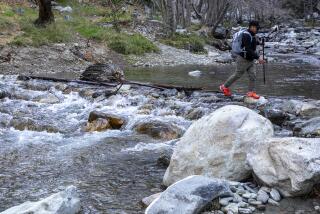Trails Show Recovery 20 Years After Eruption
- Share via
Twenty years ago a long-dormant volcano in Washington state blew its top. On May 18, 1980, Mt. St. Helens awoke with a start, spewing gases, boulders and huge hunks of glacial ice.
A 680-degree cloud of gases and organic material moved at speeds up to 300 mph. Hot, muddy liquid choked rivers. Mudflows engulfed forests.
What you saw in 1980 depended on where you stood and who you were. Loggers saw much timber lost. The military saw a land “bombed” with the equivalent of 400 million tons of TNT. Seismologists pointed to the 5.1-magnitude earthquake that caused the mountain’s bulging north face to collapse. Economists estimated $1.5 billion in damage. Meteorologists suggested the blast might have been responsible for climate changes as far away as Europe.
Wildlife biologists noted that thousands of fish were killed when water temperatures rose to boiling. Herds of elk, deer and mountain goats were wiped out.
Given the magnitude of the devastation, Mt. St. Helens’ recovery is nothing short of miraculous. For two decades, new vegetation has sprung from the ashes, beginning a process biologists call “recolonization.” The hardy fireweed led the way, followed by thistles, ferns and berry bushes. Eventually even the conifer forests will regenerate.
Animal life also has returned. Hibernating frogs and salamanders, dormant under the mud, survived. Beaver have been sighted in Spirit Lake. Every amphibian and reptile represented before the eruption has returned.
After the eruption, tourism exploded too. Apparently travelers are drawn to a landscape that resembles the Inferno rather than Paradise. Two major visitor centers serve the needs of the more than 1 million tourists a year.
My favorite longer hikes in Mt. St. Helens National Volcanic Monument include the rugged ascent (9.5 miles round trip with 4,600-foot elevation gain) to the summit via Ptarmigan Trail, and the Monitor Ridge climb. Call the national monument for climbing instructions and permits.
Another path to remember is Loowit Trail, which circles the volcano. The 28-mile trail is a fantastic exploration of nature’s devastation and regeneration, as well as a tour of old-growth forests and lands untouched by the mountain’s firestorms. The contrasts between what the eruption hit and what it missed are startling. Witnessing the flora recolonizing and wildlife returning is life affirming.
Old photos show the beauty of this place: calm, crystal-clear Spirit Lake, dramatic Harmony Falls tumbling from a nearby mountainside, a lodge and happy campers. Rising above this storybook setting was a classic, snowcapped alpine peak--Mt. St. Helens.
The modern photographer sees a different scene through the viewfinder. An avalanche triggered by the volcano’s 1980 eruption plunged into the lake, raising the water level by more than 200 feet. Monster waves surged as much as 800 feet against the ridges above the lake. As the waves and water level receded, trees blown down by the blast were dumped into the lake, there to float in what came to resemble a giant millpond. Post-blast, Spirit Lake swelled to twice its original size and occupied a onetime old-growth forest.
In the weeks before Mt. St. Helens erupted, Harry Truman, for half a century the manager of Spirit Lake Lodge, became a national celebrity when he refused the pleas of authorities who urged him to evacuate Spirit Lake. Today, Truman and the lodge lie buried beneath hundreds of feet of avalanche debris at the bottom of recast Spirit Lake.
From Harmony Falls Viewpoint, the trail switchbacks down through a fallen forest. The trees--logs now--fell in the same direction away from the volcano’s crater. Onetime scenic attraction Harmony Falls was shortened by half by earth movements and is now but a shadow of its former self. The trail ends at the ash- and rock-strewn lake shore.
Directions to trail head: Take Washington Highway 503 to the town of Cougar. Follow signs to Road 99 and go 3.7 miles to Windy Ridge Viewpoint. Park at Harmony Falls Viewpoint.
(BEGIN TEXT OF INFOBOX / INFOGRAPHIC)
Harmony Trail
WHERE: Mt. St. Helens National Volcanic Monument
DISTANCE: From Harmony Viewpoint to Spirit Lakes is 2 miles round trip.
TERRAIN: Dramatic, volcano-altered landscape.
HIGHLIGHTS: View nature’s remarkable recovery from the Big Blast.
DEGREE OF DIFFICULTY: Easy.
PRECAUTIONS: Snow sometimes lingers on the trail into June.
FOR MORE INFORMATION: Mt. St. Helens National Volcanic Monument, 42218 N.E. Yale Bridge Road, Amboy, WA 98601; tel. (360) 274-2100.
More to Read
Sign up for Essential California
The most important California stories and recommendations in your inbox every morning.
You may occasionally receive promotional content from the Los Angeles Times.













